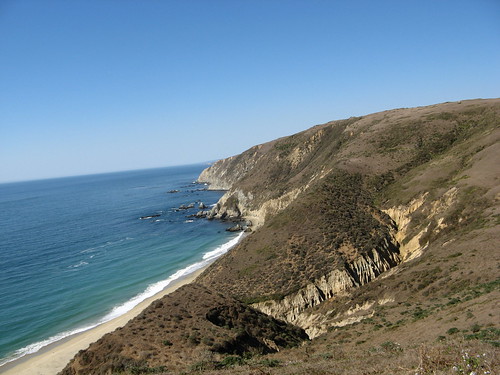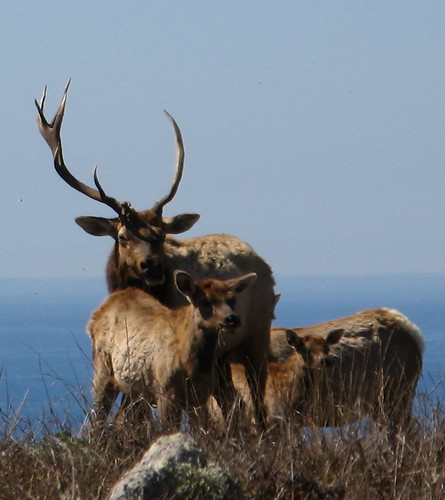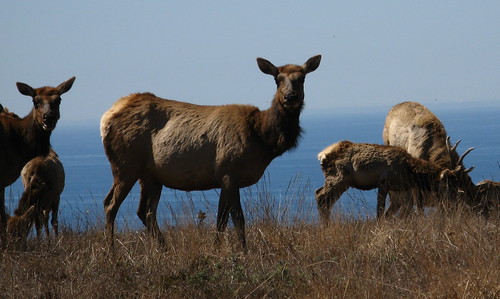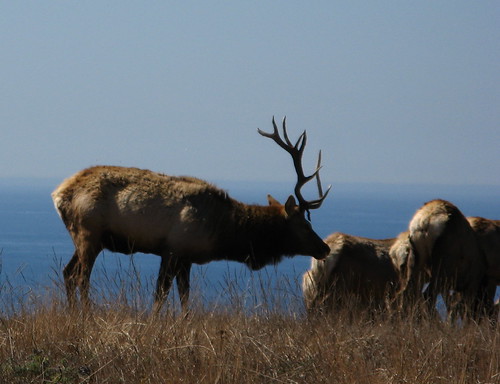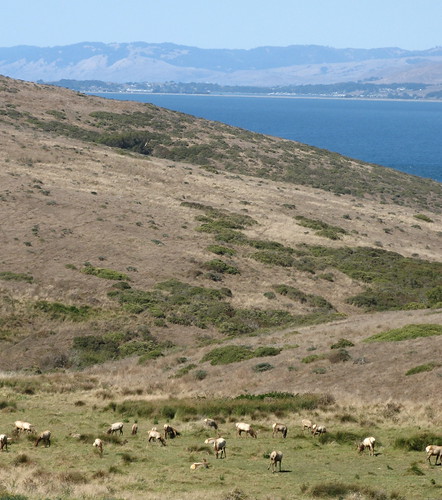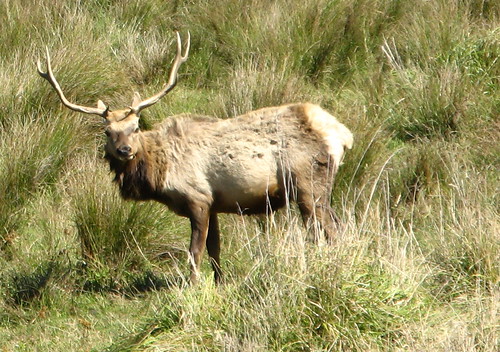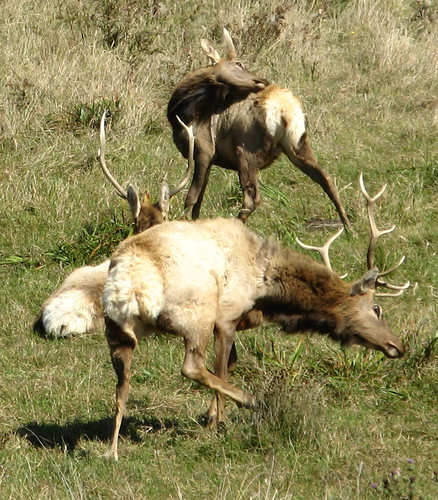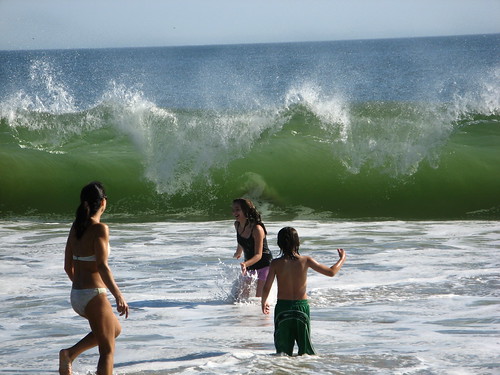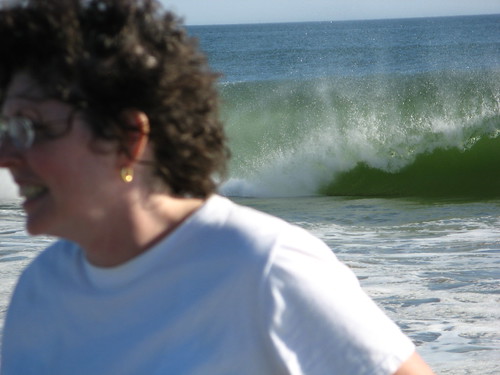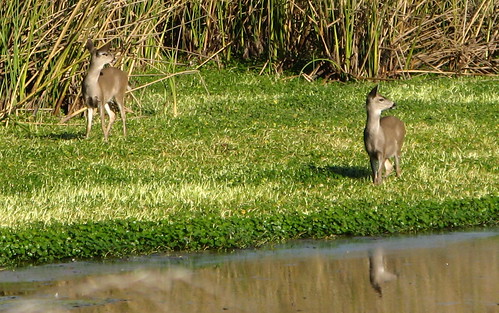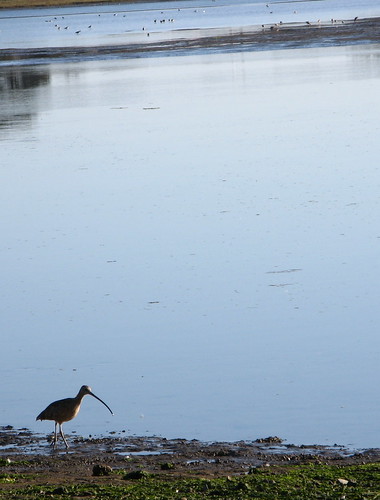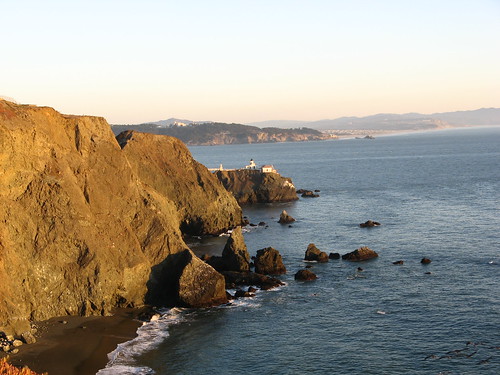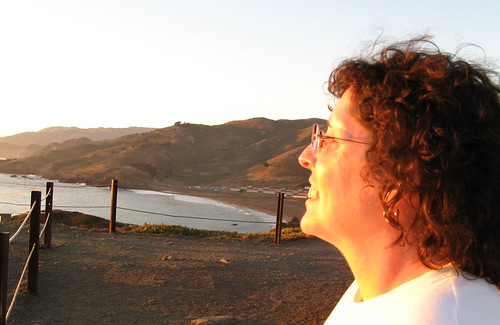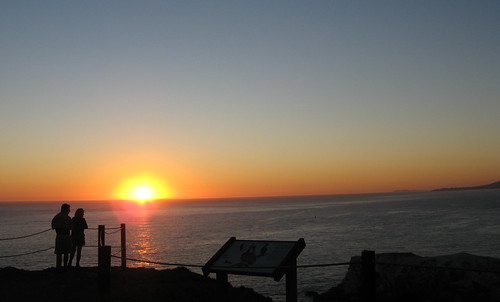Took some pretty pictures at Yosemite yesterday. Evidence here.
Author Archive for tmangan
The almost great San Jose quake of ’07
by tmangan • October 31, 2007 • 2 Comments
When the shaking stopped I turned around and saw Chuck, who sits behind me, crawling out from under his desk.
First words out of my mouth: “Looks like we’re going into Page One.” Not that anybody had to be told. The quake rattled the newsroom long enough and hard enough to send our news-detection meters into the red. At first we had no idea how bad things were: we could’ve been just down the road from a minor earthquake, or a hundred miles from one that flattened a small city.
Fortunately, it was the former: a magnitude 5.6 quake on the Calaveras Fault, within a mile of where we used to live in the hills east of town.
Nobody in the newsroom was hurt, but somebody could’ve been: A TV mounted on a high shelf tumbled to the floor with a crash. A water pipe sprang a leak near the business desk and maintenance people had to be called in. Somebody said the pressroom was the safest place to be because the entire press is on rollers. Don’t know if that was any comfort to the guys installing plates three stories up in the beast when it came to life for about 30 seconds.
The rumbling topped just after 8 p.m. and our first-edition deadline was around 11. Reports from the field started pouring into the newsroom e-mail system and everybody with a notepad and writing utensil started sending bits and pieces of the story. This was my favorite, from Food Editor Julie Kaufmann, who was at a middle school band concert:
At Spangenberg Auditorium in Palo Alto, the Jordan Middle School Symphonic Band kept right on playing “Estampie” by W. Francis McBeth when the earthquake struck in the middle of a concert.
“They didn’t tell us to stop,” said clarinetist Zoe Greene, 13, with a shrug.
“I knew the lights wouldn’t fall because of the safety cords, but I was worried about the curtain” said Chloe Koseff, another 13-year-old clarinet player whose knowledge of stage lighting safety procedures comes from her role as stage manager for the school’s theater productions.
Band conductor Vivian Boudreaux-Mikasa kept the group right on tempo during the shaking. “At first I thought it was the wind blowing outside,” she said. “If it had gone on any longer, I would have told them to duck and cover.”
Had the quake struck half an hour later, the music would have been more appropriate: John Higgins’ “Habitat (Visions of a Fragile Planet)”.
Nice touch there. (More of the Merc’s coverage here.)
Putting the story into words was challenge enough; finding pictures was another matter altogether. The quake happened after dark, so there wouldn’t be much damage within camera range. But in one of those crazy coincidences that happen only to photojournalists (I worked with a guy in Tampa who had a car crash into a travel trailer right in his viewfinder as he was shooting a picture for a story about a dangerous intersection), Richard Koci Hernandez, one of our top shooters, was interviewing a bunch of people in Willow Glen when the rumbling started. Instinctively, he started taking pictures, one of which showed a woman huddling under a sturdy table. When it was over, everybody dashed out of the house and he came to the paper with the lead photo for Page One.
My shift was up at 10 p.m. and by then the newsroom had everything pretty much under control and my prime duty — staying out out everybody’s way and attending to some non-quake-related pages — was pretty much done. I left them to their labors. If it’d been the Big One, however, I’d probably still be there.
It’s a thankful fact of life that news like this unfolds so rarely … big news is almost never good news, and we’d find nits to pick no matter how good the news is (I can see the headline: “Defense workers rue Second Coming”).
What keeps us doing it night after night, wading through story after story of lost dogs, inept public officials, this week’s scientific breakthroughs disproving last week’s breakthroughs? I can’t speak for everybody else; all I know is that the visceral rush of chasing the story after Real News happens would be declared illegal if the Drug Czar got wind of it.
Bay Area news biz, revisited
by tmangan • September 28, 2007 • 2 Comments
American Journalism Review reports on what I’ve alluded to in past posts:
The layoff-by-phone drill represented yet another backpedal from the lofty rhetoric of just 11 months earlier, when William Dean Singleton’s MediaNews Group bought the paper and its suburban cousin, the Contra Costa Times. MediaNews acquired both dailies in a complicated deal with McClatchy, which in turn had purchased them a few weeks earlier from Knight Ridder, the Merc’s deceased and dismembered former owner. “We have bought the crown jewels of Knight Ridder,” Singleton declared at the time. “They are excellent papers that we expect to make better.”
Perhaps he meant “smaller.” The first layoff at the Merc newsroom (15 people) came just four months after Singleton, known in some quarters as “Lean Dean,” assumed control. A series of resignations starting in June trimmed 15 more jobs. Combined with the Passover cuts, the newspaper’s staff had shrunk by 22 percent in the first year of the Singleton era.
The Mercury used to have more than a dozen reporters in its San Francisco peninsula bureau located about 15 miles from San Jose. Now there’s just one. The Merc gets most of its peninsula news from the short-handed San Mateo Times and the Palo Alto Daily News, a free tabloid MediaNews acquired in the Knight Ridder deal last year. Some parts of the paper’s newsroom have simply just disappeared, among them a five-member projects team that included 40-year Merc veteran Pete Carey, who was part of a group that won a Pulitzer for foreign reporting in 1986. Carey is now a business reporter.
I can also add this: We used to have 40 copy editors. Now we have 15.
Singleton says it’ll be a rough three or four years till things turn around. Well, not so rough for him, I suspect.
All day on the Marin coast
by tmangan • September 27, 2007 • 2 Comments
I can’t imagine there’s more than a couple hot days a year at the Tomales Point Trail at Point Reyes National Seashore. Yesterday, we decided to go hiking on one of them. We also drove back down the coastline, stopping at Point Reyes National Seashore’s Limantour Beach, Bolinas Lagoon and, finally, the Marin Headlands for the sunset.
So if you’re going to be out huffing and puffing through the heat under cloudless skies, there are few better places than Tomales Point — especially at this time of year, when the elk herds on the peninsula are in the midst of the “rut,” an annual orgy of sex and combat. From July through November, and every bull elk worthy of his pointy antlers will be wanting to cozy up with as many elk babes as possible.
Problem is, elk society decrees that only one really big tough bull elk — whichever one’s agile enough to fight off challengers and still find time for a little nookie — gets a harem of elk babes to himself. A few secondary bulls get lucky, but many of the losers in these battles have to wait till the next rut, next fall.
Yesterday we saw two kinds of groups: bulls guarding their harems, and a collective of bachelors. Bulls with harems stayed farther from the trail, but the bachelors we saw seemed less preoccupied with people (and presumably more preoccupied with the sex they either will or won’t get, depending on the breaks) and more inclined to hang out within camera range.
Speaking of camera range, the digicam I picked up last spring has more zoom and megapixels than previous ones, so it allows considerably better close-up action. I was never more than 30 or 40 yards from the elk. You don’t want to get too close to these guys — those antlers have too many points of impalement.
So, the pictures:
The coastline, looking north toward Tomales Point. It’s worth the two-hour drive just to see this.
A big bull elk, with some of his progeny. Looks like one half of his antlers has been worn smooth by combat.
A couple of his wives. When the gals have mugs like that, it’s understandable that the guys are more preoccupied with other anatomical area codes.
See what I mean?
Another look at Tomales Point. That blue, by the way, isn’t the color of the sea, it’s the reflection of the sky above — hence the bluer-than-usual appearance on a clear, cloudless day.
Here’s the bachelors’ quarters. All this lovely landscape set aside so large, smelly males can have a safe place to plot their attempts at amorous conquest — gotta love that.
One of the guys near a watering hole. Somewhere in Africa, a crocodile is booking his flight.
Sometimes they’ll look right at you. They are kind of cute, especially when they aren’t charging.
Seeing as how they’re guys, there is of course lots of scratching going on.
The guy on the left had the most impressive rack in the collective. Word has it he’s been insufferable ever since his audition for that Prudential ad didn’t pan out.
OK, enough large beasts. We hiked and gawked for a few hours, then headed back down the coast. We took a little detour to Limantour Beach, also part of Point Reyes National Seashore. This stretch of coast isn’t quite as wild, rocky and spectacular as the others, but it does get great waves.
A family frolics in the waters as a large wave crashes.
The family dog has a great time.
A wave crashes behind Melissa. We waded in a bit, but had no swimwear so our frolicking was a bit more restrained.
Small deer near a waterway near the beach.
After we’d gotten a suitable amount of sand wedged between our toes and into our shoes, we headed back down the road. We stopped for a minute at Bolinas Lagoon outside Stinson Beach.
A bird with a very long bill hunts for bugs in the mud flats.
Last stop on the road trip was at the Marin Headlands to watch the sunset. This is my favorite spot in Northern California, which explains why so many of my road trips include stops here.
Late evening glow on the rock face, looking south toward the lighthouse.
Melissa appreciates the fading light.
One last look, then it’s off for home.
All this for less than the price of a tank of gas. A bargain if I do say so.
Tenacity, thy name is Bob
by tmangan • September 15, 2007 • 0 Comments
On Thursday evening, it seemed impossible.
Twelve hours later, it seemed inevitable.
As Friday morning’s sun cleared the hillside and warmed our campsite, I looked to the 14,252-foot summit of White Mountain, set two days of doubts aside and asked myself a simple question: “how long could it possibly take to hike a mile and a half?”
Discovering the answer was one of the most remarkable experiences in my life.
I’ve always been the doubting type, and not because my formal name is Thomas. I fancy myself a skeptic, a rationalist, a realist. Two decades of writing headlines for a living have convinced me that the only thing exceeding the human capacity for self-delusion is our tendency to allow those delusions to cause massive calamities. I’m happier not expecting much from our species.
I know about the power of positive thinking and all that, but I also know that if something appears in my mind to be just plain impossible, it probably is.
And yet, there’s the example of 4WheelBob, the wheelchair hiker who not only did something that to my mind was transparently impossible, but got me believing it was possible, too. A month later I’m still marveling at the turnaround.
On that Friday morning of our White Mountain adventure, Bob’s bull-headed determination had drained all credibility from my skeptical outlook. The reality on the ground, as they say, obliged me to stop dwelling on how it couldn’t be done and start thinking about how it could. And that’s how Bob and I were finally of the same mind: We’ve got all day to reach the top, we concluded, and besides, how long could those last few turns of gravel road take?
Of course it would be the most most grueling day of the whole outing, a 10 hour, 45 minute marathon that obliged Bob three times to crawl up the mountain on this hands and butt when the trail got so steep and rocky that his wheelchair couldn’t get traction.
I hiked to the summit a few hours before Bob got there. I kicked back, soaked up the view and even congratulated myself: it was, after all, my first Fourteener. Most of the trail to the top is visible from the summit, and every time I looked down to see if Bob was still coming, he was still coming. Inches at a time, the rocks constantly tangling those little wheels in the front of his chair, him popping little wheelies to rise over them and push up the trail a few more inches. Painfully, excruciatingly slow going.
I think I was almost as happy as Bob was when he got to the top.
Thing is, my estimates of the impossibility of Bob’s quest had been correct all along. The original plan was to hike in a mile or so on the first day, camp out and hike to the summit and return on the second day. On Thursday, the second day, I hiked most of the way to the summit and concluded there was no earthly way Bob was getting up and down that hill in a day. And he didn’t.
But he didn’t have to. If he camped out one more night and made it to the top in one marathon slog on Friday, he reasoned, somebody could hike back to the trailhead, fetch his SUV and drive it up to a point near the summit that he could hike back to. Fortunately, one of the guys in his support crew was willing and able (he even sacrificed the opportunity to see Bob reach the top), and that’s how the impossible goal became possible.
Bob could go only so far on brute strength alone. Mental flexibility (and friends who wanted him to succeed) got him the rest of the way.
And from here on in I suspect I’ll be much more skeptical of people’s estimates of the impossible.
Out o’ town this week
by tmangan • August 20, 2007 • 0 Comments
What I’ve learned from Wall Street
by tmangan • August 17, 2007 • 3 Comments
I moved to California in 1999 with a small stake from the 401(k) at my previous job. I made just about every investing mistake on the map trying to protect that stake from the whims of Wall Street. When I finally realized I was in over my head, I parked it all in a half-dozen Vanguard mutual funds a couple years ago and let the market do its work.
The first thing I did was the worst: I put all the money into one Vanguard growth fund at one price. Which meant that not only was I hostage to whatever pain the market might inflict on that single fund, I was also hostage to a single price. As long the fund was over the $34 purchase price I was fine, but here’s the rub: In the eight years since the original transaction this fund still trades under $34.
I sold off a bunch of the fund in around 2001 or so to preserve capital. About a year later I decide that ol’ “diversify your risks” thing might be a good idea, so I divvied it up among four stock funds (a small-cap, a mid-cap, a mixed fund and the original growth fund) and two bond funds. I bought all these funds at incredible bargains because of the bear market, whose gyrations over the next couple years got me thinking I ought to try my hand at trading individual stocks, during which time I promptly squandered these bargains.
Trading stocks instructed me in a few things: 1) broker commissions are killers; and 2) it’s not for the impatient or cowardly. All I ever did was lose money.
One thing I learned from reading the blogs of active traders is that you have to have a) a system (and the discipline to stick to it): and b) an edge: something combination of insight and skill that keeps you on the profitable side of trades. If you have neither system and nor edge, you might as well toss your dollars to the breeze.
I got fed up with trading just before the bull run of 2004 that lasted up until a couple months ago. Instead of just pouring all my money back into my mutual funds at a single price, I set up an automatic investment that put bought the same dollar amount of stock each month from each fund. They call this dollar-cost averaging, and the advantage of it is obvious at times like now, when the market’s going crazy again: I buy more shares when prices are low, and fewer shares when prices are high, and I’m losing money only on the most recent purchases; all the others, bought when prices were lower, are safe (for now anyway).
In retrospect, of course, I would have made tons more money if I’d just poured all my cash back into those stock funds three years ago, but the trouble with the financial markets is it’s like trying to drive your car via the rear-view mirror. You can’t see what’s coming; all you have are the hints provided by where you’ve been.
Something else I learned: The surest way to improve your fund balance is to keep adding money to it. This is why I’ll always park at least a chunk of money in my two bond funds: they pay cash money, which gets invested in more shares of the funds. The more shares I own, the more the funds pay.
Bottom line is I can ride out the current mess without inducing an aneurysm, because I know the market won’t hit all my funds with the same force, and most of the risk is lies in the small number of shares I bought at the most recent prices; the rest are essentially safe (in the short run anyway; a protracted bear market could bite me in the fanny again, I suppose.)
When I got into the market like everybody else during the 401(k) boom of the ’90s, I had no concept of dealing with the risks. When the crash happened I had no concept of protecting my assets.
Live and learn, as they say. This spring my original 401(k) balance finally got back to where it was in 1999, and the market promptly nose-dived again. But at least my money’s spread around so I don’t have to repeat my previous errors. The fun part will be learning from the next ones (which the market will gladly provide).
What my ex-colleagues are up to
by tmangan • August 8, 2007 • 0 Comments
This morning I realized that three of my former Mercury News colleagues are running copy desks at other papers, and they’re all advertising for openings on their desks:
- Craig runs the desk at the paper in Billings, Montana.
- Courtney runs the desk at the Palm Beach Post.
- Maggie runs the desk at the Las Vegas Sun.
I”m filing this under “good to know, just in case.”
Last thoughts on Barry Bonds
by tmangan • August 8, 2007 • 0 Comments
I was in the seventh grade at a Boy Scouts gathering when Hank Aaron broke Babe Ruth’s record. I was at work when Barry Bonds hit 755 and 756 on Saturday and last night. No matter what you think of Barry, the talk of the drugs and all that, there’s something cool looking up at the TV and seeing the great record fall.
All I know about Barry Bonds is what other actual baseball fans have told me: he’s one of the most feared hitters in the history of the game. And as far as I know, there are no drugs for improving eyesight.
The playing-the-actual-game rap on Bonds was that he wasn’t a clutch hitter, that he’d come to the plate with men on base in big games and not come through with the big hits. Maybe he was a choker, or maybe he cared only about his place in the record books, but it occurred to me that he might simply have become too good for his own good. With the game on the line and no choice but to pitch to Bonds, no pitcher would dare risk throwing anything Bonds had a chance of blasting out of the park.
Imagine how much sooner Bonds would’ve broken this record if intentional walks were illegal.
Shakespeare would’ve had a ball with this story: a guy desperate to stake his place among the legends of his game makes an ethical compromise that gives him a shot at his place in history, but history judges him a cheater. He gets so good that nobody dares to compete with him. It’s not a game anymore, it’s just everybody going through the motions for several summers and hoping that as soon as he breaks his damn record, he’ll just go the hell away.
How’s that for cosmic justice?
I dreamed I saw George W. Bush last night…
by tmangan • August 8, 2007 • 0 Comments
He was playing a six-string acoustic bass guitar, and was rather good. I remember wondering why we hadn’t been told of this skill, considering all the attention that attended Bill Clinton’s saxophone playing.
He was unfailingly polite and charming, the kidder and prankster we’ve been told of. A little boy, a toddler of 2 or so, was nearby, and the president tossed a soccer ball his way. The ball hit the boy on the head, knocking him on his diapered butt. He started wailing.
Later I was bragging to somebody about going to the White House, but I didn’t mention the baby.

